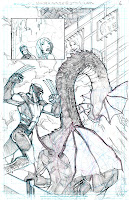Got the response from Marvel. Which was basically keep working. However they did give me some things to work on and tips. So figured you guys would like to see it also. These are things I've often felt I was lacking in and I am not really sure how to fix. Anatomy, perspective, no problem. I know how to study and practice those. But depth and cinematography? I think those are more natural born talents that are harder to hone.
"Change how close and how far away your camera is from the action. You are using mostly one distance from the action and it makes the story feel static. Make the reader feel like they are there in the scene with them. Move the camera around so the readers feel like they are moving around with the action, dodging out of the way of the characters, looking over their shoulders, knocked down and looking up at them etc. Pull the camera out to show more of the figures.
I’d suggest bringing as much scope to the panels as possible, with backgrounds and camera angles and camera distance. You’re doing that already but take it to another level. Think how Olivier Coipel is able to make even a two head shot feel like a window on a wider, grander world instead of a box around two heads. Make the reader feel like they can step through the panel and join the characters.
Try to draw the most exciting second of actions. It’s not enough to draw what is happening, but to capture the exact second when things are most exciting so the art is most exciting. Imagine what a sports photographer would look for if they’re trying to photograph a football game. What would be THE shot that would land them on the front page of a newspaper. This doesn’t have to be every panel but makes the story more dynamic and active. The reader then imagines the actions that led up to that panel and the ones afterwards and engages them more with the story."
Here are the pages I submitted.
"Change how close and how far away your camera is from the action. You are using mostly one distance from the action and it makes the story feel static. Make the reader feel like they are there in the scene with them. Move the camera around so the readers feel like they are moving around with the action, dodging out of the way of the characters, looking over their shoulders, knocked down and looking up at them etc. Pull the camera out to show more of the figures.
I’d suggest bringing as much scope to the panels as possible, with backgrounds and camera angles and camera distance. You’re doing that already but take it to another level. Think how Olivier Coipel is able to make even a two head shot feel like a window on a wider, grander world instead of a box around two heads. Make the reader feel like they can step through the panel and join the characters.
Try to draw the most exciting second of actions. It’s not enough to draw what is happening, but to capture the exact second when things are most exciting so the art is most exciting. Imagine what a sports photographer would look for if they’re trying to photograph a football game. What would be THE shot that would land them on the front page of a newspaper. This doesn’t have to be every panel but makes the story more dynamic and active. The reader then imagines the actions that led up to that panel and the ones afterwards and engages them more with the story."
Here are the pages I submitted.







It's pretty cool that they gave you that feedback with helpful tips. I agree that what they are suggesting to work on is difficult and the only way I've found is through practice and getting honest feedback. Sometimes I can look at a finished page and see what does and doesn't work for me but it's when I show it to others and they think "Yeah, it would have been cooler if you had done X here and Y there." It gives me ideas for what does and doesn't work the next time I do a scene similar to it.
ReplyDeleteAnd from what I see of the Marvel artists a lot of them learn those things from working at the smaller companies and getting feedback from editors and such along the way. They usually don't have those skills in their early work.
Just the fact you were able to complete the pages PLUS submit them and get feedback says alot Wally. You'll be remembered by the editor as someone who followed through on what they said they would do.
ReplyDeleteThanks for posting the tips too...gives me some advice I'll try to implement in my own pages.